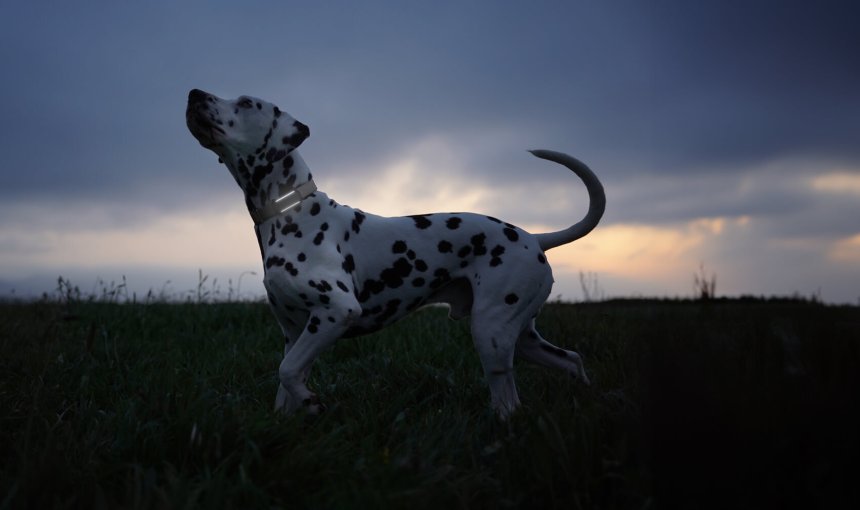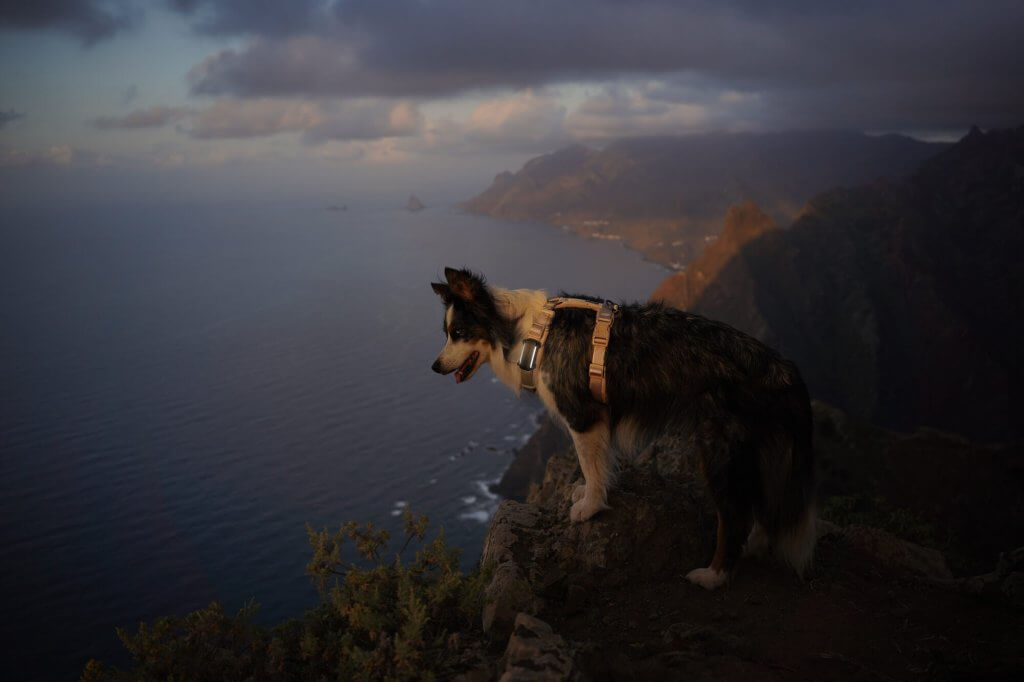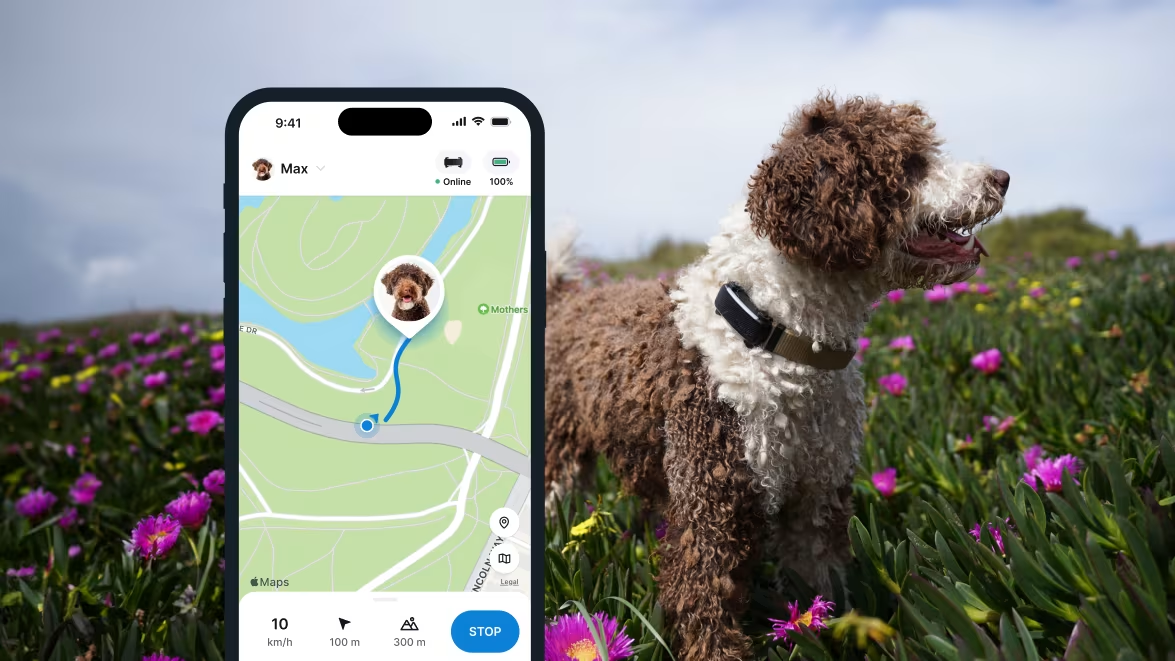8 Steps To Safely Walk Your Dog In The Dark
Both you & your buddy love your daily walks together - but how do you keep them safe when it's dark outdoors?

As fall gets closer, you might’ve wondered how to continue your daily dog walk routine as the days start getting shorter – and darker. After all, walking a dog in the dark means it’s that much easier to lose them if they slip off-leash at night. Or, worse, get injured by a passing car or cyclist. But not to fear; with a little preparation and smart thinking, it’s 100% possible to safely walk your dog safely in the dark. We’ll cover some important safety tips – plus how to track down a missing dog in the dark with 100% peace of mind – every time.
Key Takeaways
Be prepared.
Before you head out, put an ID tag and microchip on your dog, and use a strong leash and harness. It’s also a good idea to spay or neuter your dog to reduce the chance of them running off.
Be visible.
Use reflective gear like vests, collars, and leashes, and carry a flashlight or use an LED collar.
Be aware.
Plan your route and stick to well-lit, familiar paths. Pay attention to your surroundings and be mindful of your dog’s reactions to things that might spook them, like cars or strangers.
Be smart.
Keep an eye out for potential hazards like dognappers, frozen ponds, or icy walkways. If your dog is a flight risk, consider a smart dog tracker with real-time GPS tracking for peace of mind.

Always know your buddy is healthy & safe
Read more10 Tips for walking your dog in the dark
1. Make sure your dog is easy to identify
Having a dog ID tag with a collar can potentially save your buddy’s life. This ensures a helpful stranger knows to return them to you. The last thing you want is to lose your dog in the darkness and then have no way to be reunited with them again.
“Only 15% of lost dogs without ID tags or microchip are reunited with their family.”
– American Humane
So before you head out on a walk, make sure your buddy has an ID tag on their collar. It should include your dog’s name and your phone number clearly legible. Better yet, a dog microchip implanted by a vet will work like a permanent ID tag. Make sure to keep your contact details up-to-date in the microchip database.
2. Consider getting your dog fixed
Un-neutered male dogs or female dogs in heat are way more likely to try to run away than neutered pets. A dog following their strong natural mating instinct will be ready to chase any opportunity they get for a little action. Your vet can best advise you whether getting your dog spayed or neutered is a good option at this time.
3. Invest in an extra-strong leash & harness
In many areas, leash laws require that you walk your dog on a lead. Elsewhere, you might also need to check if your dog needs a muzzle. Of course, if you know of an area where it’s safe to walk your dog off leash, that’s fine too. But in general, having a leash and harness can prevent a curious puppy from running away. Or help you intervene if your old dog wants to wander off. It’s important to respect passersby by keeping your dog in line as well.
4. Don’t skip out on basic obedience training
Even the best-trained dogs can fall prey to their own flight instinct. It might seem tedious practicing “Stay,” “Come back,” and “Drop it” nearly every day – but it can make all the difference when you’re both out on a walk in the dark.
5. Dress for visibility
Low visibility at nighttime isn’t just annoying – it can be life-threatening. (Especially if your walking route includes passing cars, animal traps, or wildlife.) So it’s important that both you and your dog are visible to passersby to avoid any accidents in poorly-lit areas. Here are some visibility gear ideas for walking your dog at night:
- Use reflective gear.
This goes for you and your dog. Reflective dog scarves, collars, harnesses, leashes, vests, jackets and more are all good ideas. Reflective gear is anything that reflects light, making both of you more visible. - Lights.
Try an LED or light up dog collar and/or leash, and bring a flashlight or headlamp with you. This is especially important if you go walking in a dark area. - Glow-in-the-dark items,
Like, for example, the lights of the Tractive smart dog tracker or a glow-in-the-dark dog toy.

6. Plan for the weather
For example, if you have a small dog that gets cold easily, consider a warm dog jacket or insulating vest on frosty winter nights. Make sure you’re dressed warmly while you’re at it.If you’re walking in a wet, muddy, or rocky area, consider getting your buddy a pair of dog booties to keep their paws warm, dry, and safe.
Read more: 8 Best Tips On How To Protect Dog Paws In Snow
7. Watch out – your dog might spook in the dark!
Even if your dog doesn’t spook easily, it can still be frightening for them to encounter passing cars or even strangers when it’s dark outdoors. Even the sight of a warmly-dressed stranger (in a hat, muffler, or scarf) can be disconcerting for them. Keep some treats around and double down on obedience commands like “Sit,” and “Stay” to prevent them from bolting.
8. Prepare for the unexpected
Finally, keep in mind that there are likely other factors you need to consider on your personal nighttime dog walks.
- Beware of ice-melting salts that can be dangerous for your dog’s paws.
- Is dognapping on the rise in your area? Then don’t let your dog out of your sight.
- Choose a walking path that is safe, well-lit, and dog-friendly. Stay alert – surprises such as other people and dogs, cars, cyclists, or wild animals might greet you unexpectedly.
⚠️ Is there a frozen lake nearby? Then keep your dog close. Else, your buddy’s weight might end up with them crashing through – like Imogen the Borzoi, pictured here with her Tractive device.

Luckily, Imogen’s mom was able to track her down with her Tractive device’s Heat Map and Location History – saving her from drowning and freezing.
Read more: Imogen The Dog Saved From Frozen Lake Thanks To GPS Tracker
Where a smart dog tracker can prevent an emergency
A sudden noise, an approaching car, or the sight of another animal could cause your dog to bolt, leaving you in a panic in the dark. This is where a smart dog tracker like Tractive can help prevent a “lost dog” situation.

Strapped to your dog’s collar, you can now:
Track their every step in real-time
Your Tractive tracker offers real-time GPS tracking with unlimited range. If your dog runs off, you can instantly switch to “LIVE Tracking” on the Tractive app, which provides location updates every couple of seconds. This allows you to see your dog’s exact path and pinpoint their location on a map, making it more likely you’ll find them in no time.
Unlike a microchip, which only identifies your dog once they’ve been found, a GPS tracker actively helps you locate them as they move. Also unlike an AirTag, your Tractive device doesn’t need a network of compatible devices to work.
Find your dog no matter how dark it is outside
When it’s dark, finding a runaway dog can be a challenge, even if you know their general location. From the Tractive app, you can remotely activate an LED light on the tracker, which makes it easier to spot your dog from a distance.
If that doesn’t work, you can also trigger a high-pitched melody via the Sound option to help you listen for them, especially if they are hiding in dense bushes or in a low-visibility area.
Get your friends & family to help
Emergencies are often a team effort. With Tractive’s Family Sharing feature, you can grant trusted friends and family members access to your dog’s real-time location. In a worst-case scenario where your dog goes missing, you can quickly share their LIVE location with your support network. With multiple people helping in the search, it’ll now be more likely someone might find your dog and bring them home safely.

Follow your dog anywhere
Get real-time location information, wherever they go. And find out when they try to make an escape, or just when they go somewhere they shouldn’t, with Virtual Fences.
And if you’ve liked this post, share it with a friend or a loved one – and let’s help build a safer, kinder world for our furry friends together.



